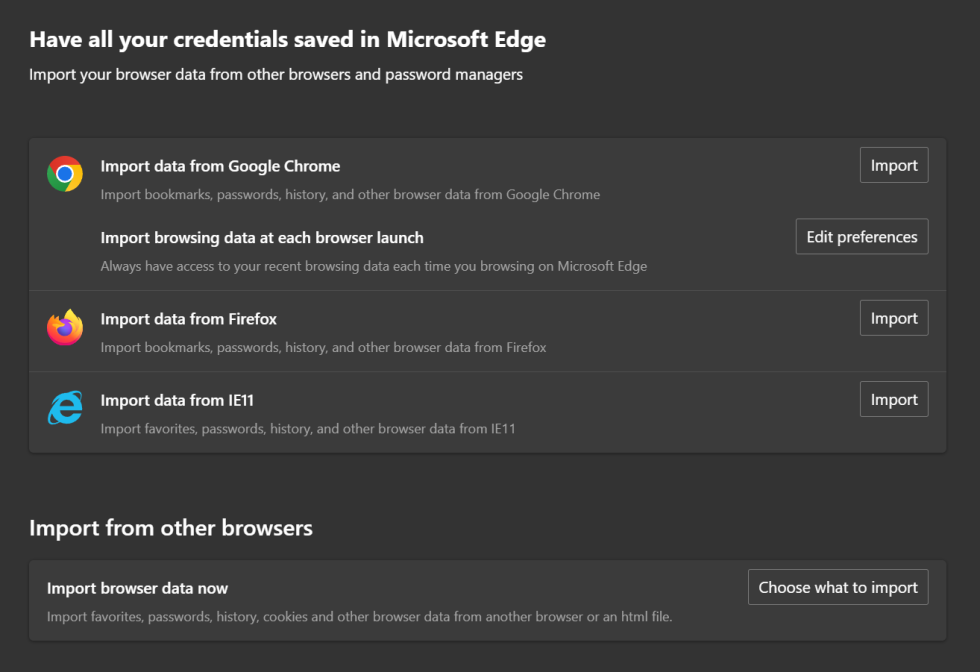Edge update is first proof that this was definitely a glitch.

Microsoft has fixed a problem that resulted in tabs from Google Chrome being imported to Microsoft Edge without user consent, as spotted by The Verge. Microsoft has kept mum on the situation, making the issued update the first time Microsoft has identified this as a problem, rather than typical behavior for the world’s third-most-popular browser.
In late January, The Verge Senior Editor Tom Warren reported experiencing the puzzling Edge issue. After updating his computer, Edge launched with the tabs that Warren most recently used in Chrome. He eventually realized that Edge has a feature you can toggle, reading: “Always have access to your recent browsing data each time you browse on Microsoft Edge.” The setting is reachable in Edge by typing “edge://settings/profiles/importBrowsingData.” Interestingly, it allows Edge to import browsing data from Chrome every time you open Edge, but data from Firefox can only be imported manually. However, Edge was seizing Chrome tabs without this setting enabled. Others reported having this problem via Microsoft’s support forum and social media, as well.

Microsoft didn’t respond to The Verge’s initial request for comment, but this week it released an Edge update that seems to address matters. Microsoft’s release notes from February 15 say:
ADVERTISING
Edge has a feature that provides an option to import browser data on each launch from other browsers with user consent. This feature’s state might not have been syncing and displaying correctly across multiple devices. This is fixed.
Microsoft seems to be saying that the status (enabled or disabled) of Edge’s importing data ability wasn’t syncing correctly across people’s Microsoft devices. However, this doesn’t explain the number of users who claimed they saw the problem without having the feature enabled. Microsoft declined Ars Technica’s request for comment.Advertisement
With this fix, Microsoft is claiming that the behavior was, indeed, unintentional. But that wasn’t a given. Besides the fact that Microsoft hasn’t provided more details about the problem, the company also has a history of both sneakily and overtly trying to coerce people into using Edge. You’ll see Microsoft pester you with pop-up messages if you try to download Chrome or change your default browser, for example.
Edge and Chrome are both based on the Chromium browsing engine, but Chrome has long maintained a massive lead over Edge in terms of market share. Global Statcounter data points to Chrome having 64.41 percent market share last month, followed by Safari (18.82 percent), and then Edge (5.36 percent). The numbers inch slightly more in Microsoft’s favor when looking at the US market specifically (9.31 percent share in January), although Chrome still dominated (49.06 percent).
- Browser market share for the past year globally. Statcounter
- Browser market share for the past year in the US. Statcounter

Like many web browsers, Edge has a hard time competing with Chrome, which ties in with other popular Google services, like Gmail. Similarly, Edge promotes Microsoft offerings, including coupons, Microsoft accounts, and, as of recently, Copilot.
Edge pulling Chrome tabs seemed to fit in with pushy strategies Microsoft has employed to get people on its browser and other products, like Microsoft 365. Without more information, we don’t know when Microsoft first knew about Edge’s unwanted tab replication or how long it took to make it stop. Regardless, Microsoft doesn’t intend for tab swiping to be part of the Edge experience currently, so at least this particular nuisance should be over.




